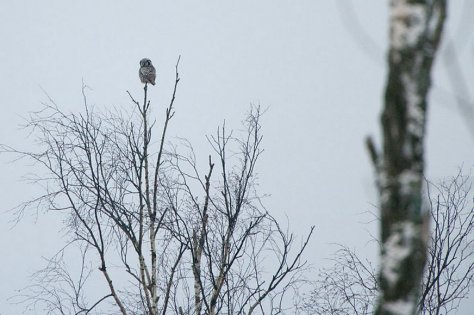Meeting a hawk owl is a matter of luck
Photos Arne Ader
Translation Liis
Hawk owl
Hawk owl Vöötkakk Surnia ulula
Hawk owls have nested in Estonia only occasionally and they are not often encountere, neither as passing migrants nor winterers. In late autumn they can be expected to arrive; the winterers may be up to some twenty individuals and most probably in the Pärnu or Lääne counties, also at the northern coast.
Compared to the quite well known Ural owl the hawk owl is half as big, or the size of a jackdaw, but similarly with a long tail that in a comparison would rather fit a sparrowhawk. Body length around 40 centimetres, wingspan up to 80 centimeters; the weight can vary strongly between individuals: from little more than a few hundred grams to almost 400 grams.
The sex of hawk owls cannot be distinguished in nature. It is the only Estonian owl with a the belly plumage with clearly visible cross bands. Plumage in flight view similar to that of a sparrowhawk that the hawk owl can be confused with: the daytime hunting habit fits well with the activities of sparrowhawks. Hunting is generally done in open landscapes, fields or cutting lots where it hunts for voles. A characteristic standing or hovering flight. Hawk owls like high observation points, see Arne’s photos..
The plumage of hawk owls is patterned in black, dark brown, white. The head is proportionally small compared to other owls. The whitish face is circled by black bands and raised eyebrows; the gaze of the yellow eyes seems piercing which is emphasized by the yellow bird of prey beak. Legs feathered and claws blackish brown.
The passing migrants are mobile but the winterers can be quite true to a location of only a few square kilometres if prey is present.
Observations of hawk owls: LINK
Hawk owl










